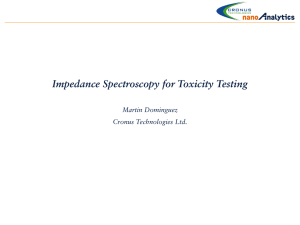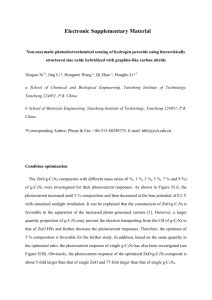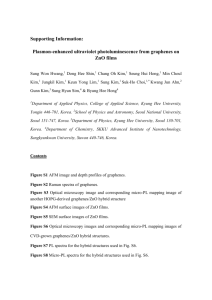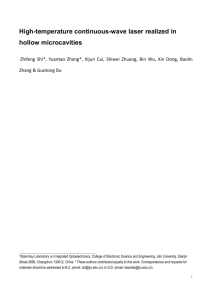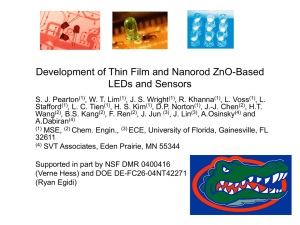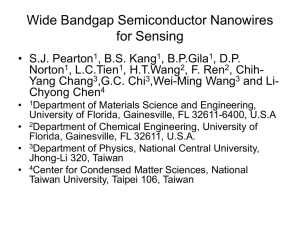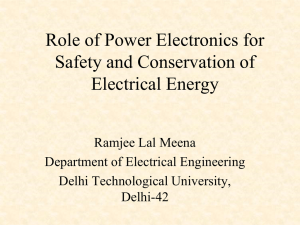Fabrication and Characterization of Well-Aligned Zinc
advertisement
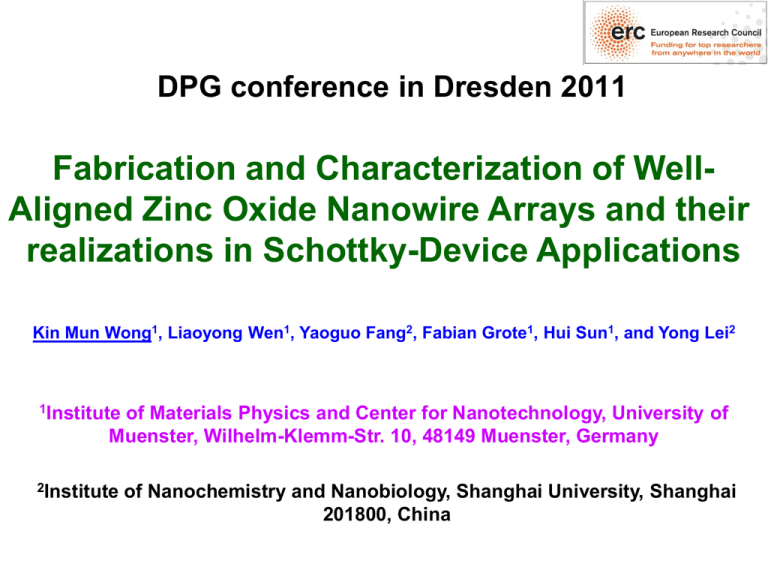
DPG conference in Dresden 2011 Fabrication and Characterization of WellAligned Zinc Oxide Nanowire Arrays and their realizations in Schottky-Device Applications Kin Mun Wong1, Liaoyong Wen1, Yaoguo Fang2, Fabian Grote1, Hui Sun1, and Yong Lei2 1Institute of Materials Physics and Center for Nanotechnology, University of Muenster, Wilhelm-Klemm-Str. 10, 48149 Muenster, Germany 2Institute of Nanochemistry and Nanobiology, Shanghai University, Shanghai 201800, China Outline • Fabrication of well aligned ZnO NWs arrays using UTAM as a substrate • Device application of the ZnO NWs arrays as Schottky Diodes Fabrication of well aligned vertical ZnO NWs on ultrathin alumina membranes (a) Au nanodots UTAM 0.5 μm (b) 1μm (c) 1 μm ZnO NWs on the UTAM are grown by CVD at 550 oC under 400 mbar at a constant nitrogen flow of 150 cm3/min Well vertical alignment of the ZnO NWs due to the well ordered underlying UTAM pore structure Growth process of the vertical well ordered ZnO nanowires arrays (a) (b) (d) (c) (a) Thermal Evaporation of Au on the UTAM surface (b) ZnO + C → Zn + CO (by graphite), negative charges (e.g. C2O42-) attract Zn atoms to the UTAM for the nucleation process to begin (c) Mergence of the Zn atoms into (0001)-oriented quasihexagonal ZnO nuclei upon precipitation and oxidation (d) Due to the intense (0001)-oriented growth direction, vertical ZnO NWs are formed after prolonged growth from the nuclei Process of fabricating horizontal arrays of ZnO NWs Schottky diodes The ZnO NWs as constructed by our method are densely packed (with approximately 4x105 NWs in an area of 1 cm-2) and are demonstrated to be functional as Schottky diodes. The overall process of fabricating horizontal arrays of ZnO NWs Schottky diodes (a) (b) Length of the ZnO NWs reach 181 m in 40 minutes (c) (d) Rapid growth of the NWs due to the plentiful supply of zinc vapor and oxygen near the substrate Temperature : 950 oC Growth of the ZnO NWs by the CVD process Dry contact printing process for the realization of the well aligned arrays of ZnO Schottky diodes (a) (b) Directional sliding of the donor substrate with respect to the receiver substrate NWs were effectively sheared from the donor substrate (c) (d) 90% of the NWs are highly Aligned in the direction of the Sliding motion NWs are aligned along the [0001] direction (or c-axis), retain their orginal alignment on the donor substrate Separation between the electrodes 20 m Ag electrodes on the ZnO NWs formed by thermal evaporation I-V Characterization of the Zinc Oxide Nanowire Arrays (a) Movement of the positive and negative probes along the neighbouring pairs of electrodes for the I-V measurements (b) Rectifying behavior in the negative voltage region with some differences in the forward biased current for all the 9 electrode pairs I-V characteristics of horizontally aligned ZnO NWs arrays of Schottky diodes (b) (a) Zinc and oxygen alternating layers along the c-axis results in a spontaneous polarization, P which leads to a potential gradient along the length of the individual NW P, which is oriented along the NW direction (towards the source electrode) leads to a build in potential decreasing along the NW c-axis direction Decrease of the foward biased current when the number of sequential electrodes increases due to the increased number of Schottky barriers Increase in the turn on voltage (b) 20 (a) 16 # 1 electrode # 2 electrode # 3 electrode # 4 electrode # 5 electrode # 6 electrode # 7 electrode # 8 electrode # 9 electrode I (nA) 12 8 4 25 μm 0 -3 -2 -1 0 1 2 3 Vds (voltage) SEM image of a single ZnO NW device on the Si substrate Length of the ZnO NW ~ 100 m I-V characteristics of nine different single ZnO NW Schottky diode 1,0 Single ZnO NW Schottky diodes Barrier Height, d (eV) 0,9 0,8 The ideality factor and the barrier height of the single ZnO NW Schottky diode is obtained from the respective I-V characteristics 0,7 0,6 0,5 0,4 8 10 12 14 16 18 20 Ideality Factor Weak linear dependency of the barrier height on the ideality factor indicates lateral inhomogeneity of the ZnO NW Schottky contacts due to the difference in the inhomogeneity in the Schottky contact corresponding to the different diode-to-diode interface The high ideality factor is due to the interface states of the thin interfacial layer between the Ag electrode and the ZnO NW as an interfacial layer with surface states forms easily on the surface of the ZnO NW Conclusion •Fabrication of well-aligned arrays of vertical ZnO nanowires using an UTAM as a substrate •Fabrication of a large area of repeatable, densely packed and horizontally well-aligned arrays of ZnO NWs Schottky diodes along their c-axis using a simple and viable two-step method •Our technique for the realization of Schottky device applications opens a possibility for the mass scale production of the ZnO NW based devices for flexible electronics. Acknowledgements Surface Nano-Structuring Group Group Leader: Prof. Dr. Yong Lei Group Members: Stefan Bartels Fabian Grote Christian Heckel Peter Heß Stefan Ostendorp Dr. Hui Sun Nina Winkler Dr. Kin Mun Wong Feng Xu Dr. Shikuan Yang Dr. Huaping Zhao Funding Thank you for your attention
